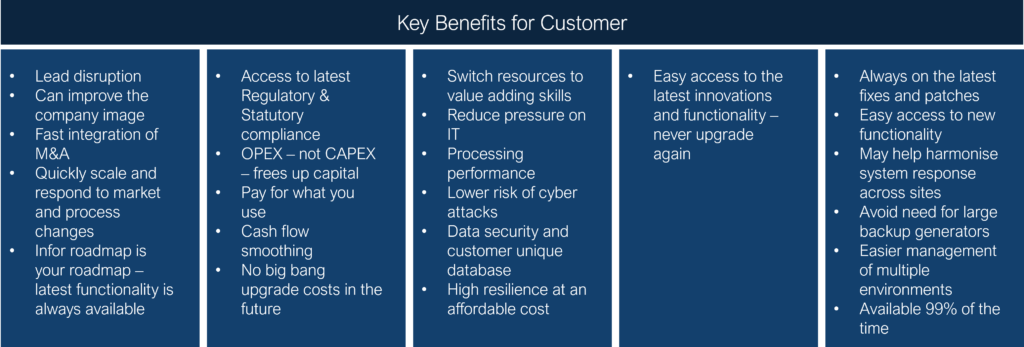Multi-site Cloud migration need not be complex
Cloud migration in your enterprise, particularly if operations are spread across several global sites, could appear as an encouraging prospect. The benefits of Cloud migration are many and far-reaching; it protects your enterprise-critical data, lowers the total cost of ownership (TCO), gives you the flexibility to scale your operations, and enables you to make the best use of your team for value-added initiatives.
Yet, multi-Cloud migration could also appear as a challenging prospect, and you may have many questions. There is IT architecture complexity and legacy systems to contend with; possible data security compromises and multiple security layers to address (application, network, data centers, and infrastructure), network latency, deployment models, along with team readiness and any knowledge gaps. Cost management is central to any Cloud migration process. One study found that Cloud migration inefficiencies can increase costs by 14% annually compared to the originally planned amount, with delays in the process in some cases. This same study also discovered that enterprises with successful Cloud migration outcomes often have CEOs who actively champion the cause, map out the implementation process at the beginning itself, and ensure the team is equipped with the necessary skill sets.
Clearly, there are lessons for any enterprise from those that have succeeded with their Cloud migration strategies. The starting point is to remember that Cloud migration is an incremental process. Sustainability and scalability must become the main drivers of your multi-site Cloud migration strategy if your enterprise is to leverage its many benefits for the long term. It encompasses building a repeatable global solutions template, minimizing risks through predictability, creating a sustainable delivery structure, and incorporating technologies such as Robotic Process Automation (RPA) and Intelligent Automation (IA).
| Key Benefits for Customer | ||||
|---|---|---|---|---|
|
|
|
|
|

Build a customizable and repeatable global solution template
Your team must think about geographical location and regional or country-specific differences as a global enterprise. Building a global template that you can repeat as and when needed across all your sites will become indispensable. Spending considerable time on the initial design and discovery phase will define the success of your multi-site Cloud migration process. As a part of this process, you will need to:
- Perform a comprehensive needs analysis
- Consider all your enterprise applications, devices, and users; your infrastructure, including any legacy systems and security and governance policies that need updating
- Understand how to leverage existing data
- Budget forecasting
- Consider how your migration process and its implementation will differ across regions as a part of this analysis
This initial phase requires extensive stakeholder consultation to understand these concerns.
Given the many different factors involved, standardization is an imperative. Standardizing processes and tools across all your sites makes post-migration management, maintenance of consistency, and quality at all your sites much easier – especially when you decide to scale your operations. Modifications and customization also become important components of your global template. Any global enterprise has to strike a careful balance between global standards and local flexibility. Discuss how you will respond to specific local requirements without compromising the overall integrity of the solution. Often, a Cloud solution will require integrations and extensions based on its unique use case.
For example, a food manufacturer with facilities based in Australia and New Zealand succeeded in their multi-plant Cloud ERP implementation through custom integrations. The lack of integration in their facilities resulted in a lack of supply chain and inventory visibility and traceability, manual data transfers, and production inefficiencies. All of these issues incurred additional costs for the manufacturer. Fortude implemented Infor M3 for manufacturing operations at one site. At the other, Fortude automated processes, rectified integration issues, rolled out a maintenance management model, and configured a new warehouse. The manufacturer gained much needed end-to-end supply chain visibility, which simplified inventory management, improved production processes, and automated manual processes.
Minimize Cloud migration risks through predictability
It is obvious that risks increase when many sites are involved. We believe in predictability as an integral component of a multi-site Cloud migration to help mitigate these risks. Predictability, too, is linked to the initial stages of formulating a global template. Standardizing processes results in predictable timelines and budgets that your enterprise can adhere to throughout the implementation. These have to be clearly communicated to your entire team for thorough planning so that you do not have to deal with extra costs due to inefficiencies in your migration.
Predictability is also achieved by performing an enterprise-wide risk assessment and understanding potential flaws in your systems. You are then able to introduce a strong governance framework with a governance policy that addresses these potential risks and compliance monitoring to ensure that your migration will not be exposed to security risks.
However, no matter how comprehensive you aim to be when crafting such a framework, risks can occur. It is here that you will need additional risk mitigation strategies that include proactive audits to identify risks early and practical risk mitigation tips such as testing, phased rollouts, and pilot programs. Test automation tools such as Fortest developed by Fortude help to streamline your testing process. Use Fortest to automate regression testing, access pre-built functions, and create customized industry-specific tasks. You can also work with an Applications Managed Service Provider who will perform 24/7 monitoring, maintenance, incident resolution, and contribute to your team’s skill set.
Craft a sustainable delivery structure for your move to the Infor Cloud
Ensuring that your Cloud migration strategy is sustainable must address the people-factor along with the technology. This is why the initial stakeholder consultation is important before you begin mapping out your global template. Think of your entire team (including both onsite and offshore), how the migration will affect their daily tasks, and what needs to be prioritized. Finalize the roles and responsibilities of each sub-team within your enterprise to ensure there is alignment among all teams and any external consultants to avoid miscommunications. An efficient project management system will need meticulous documentation, as this will help you identify the mission-critical tasks and enable your team to prioritize them.
A diverse team with various experience levels and expertise is an advantage. In our experience, a multi-tiered team approach applied to such teams helps initiate the necessary knowledge transfer and ensure continuous support once the migration starts. This approach also helps to accelerate multi-site Cloud deployment through synchronized workflows and adoption of technology tools that ultimately make project management more efficient.
Use RPA and IA to get the most out of the Cloud
RPA, or applications that emulate certain human tasks, has been gaining traction over the years. When deployed strategically, RPA performs mundane, repetitive tasks, saving operational costs for enterprises and shortening processing times. RPA adoption also boosts productivity with the team engaging in tasks more aligned with their areas of expertise; it improves efficiency by reducing potential human errors; and it even supports data analysis. Using RPA in your Cloud migration process contributes to making this a smoother operation. Your enterprise can leverage RPA to automate data transfer between systems and devices, monitor Cloud resources, and perform routine maintenance tasks.
The same benefits are replicated in any Cloud-based operation. Take the example of a food and beverage manufacturer that built a fully automated trade spend system, entirely transforming a process that originally took 72 days annually from their team. This manufacturer increased their accuracy rate by an impressive 99%. Prior to the introduction of RPA, the trade spend process consisted of manual, time-consuming tasks with a high likelihood of errors. This manufacturer is also fast-tracking automation of other processes, as the team’s confidence has improved significantly post-RPA.
The advantages of RPA go further with developments in Artificial Intelligence (AI). Think of an attended bot that becomes an unattended bot through the incorporation of AI. This is what is referred to as Intelligent Automation (or IA). According to one prediction, AI will generate an estimated 15% of new applications without any human input by 2027. The effects of such a transformation will be felt in all industries, with long-term implications. IA will become an integral part of your Cloud-based operations to improve performance, make processes more cost-effective, and improve compliance.
Assess your Cloud readiness
Fortude recently worked with a European-based aquaculture feed manufacturer with global operations to implement a multi-site Cloud ERP solution in 26 warehouses. The implementation spans multiple functions (sales, procurement, warehouse management, manufacturing, formulation, quality, and finance). Our Cloud management strategy is informed by projects such as this and other engagements with diverse enterprises. A repeatable global template that balances global standards and local needs, together with a thorough stakeholder consultation, gives you the foundation to build your Cloud migration process and Cloud-based functions. Post-migration management becomes easier with standardization and customization; it further helps with risk assessment and mitigation. Of course, no Cloud strategy is complete without emphasizing the people-factor. A multi-tiered team approach, clarity on roles, and efficient project management are important factors to ensure your delivery structure is sustainable. And finally, RPA and IA will give you that important edge to succeed in an innovative, technologically driven business environment.
Cloud migration becomes a catalyst for digital transformation. Fortude’s Cloud consulting practice oversees all stages of your enterprise journey with Infor CloudSuite. Whether you need implementation, upgrades, optimization, or support – we will provide you with the necessary tools and guidance. Sign up for our complimentary Cloud Readiness Assessment and walk-away with a high-level plan that covers the approach, cost and time required to make your move to the Cloud seamless.
FAQs
IT architecture complexity, especially legacy systems and integration challenges; multiple security layers; network latency; any impacts on data security and regulatory compliance; budgets and adherence to the original forecast; team readiness; and any skills gaps are some common key challenges that any enterprise must consider prior to starting their multi-site global Cloud migration process.
Build a repeatable global template that addresses global standards and local customizations. Standardize processes and tools for consistency. Understand how best to leverage existing data for continuity. Make an inventory of all applications, devices, users, and infrastructure that need upgrading. Identify issues that could impact data consistency and synchronization through extensive stakeholder consultations.
Ensure that your team can follow predictable plans and budgets. Standardize processes so that your team can follow predictable timelines. Adopt a multi-tiered team approach and communicate team roles clearly for efficient project management. Perform an enterprise-wide risk assessment to understand potential flaws and implement proactive mitigation strategies.
By introducing a strong governance framework following your enterprise-wide risk assessment. This framework must consist of a governance policy that addresses potential risks and compliance monitoring to ensure that your migration will follow all necessary compliance and regulatory issues that may arise while protecting your data. Also, consider RPA adoption.
- Multi-site Cloud migration need not be complex
- Build a customizable and repeatable global solution template
- Minimize Cloud migration risks through predictability
- Craft a sustainable delivery structure for your move to the Infor Cloud
- Use RPA and IA to get the most out of the Cloud
- Assess your Cloud readiness
- FAQ
Related Blogs
Subscribe to our blog to know all the things we do


